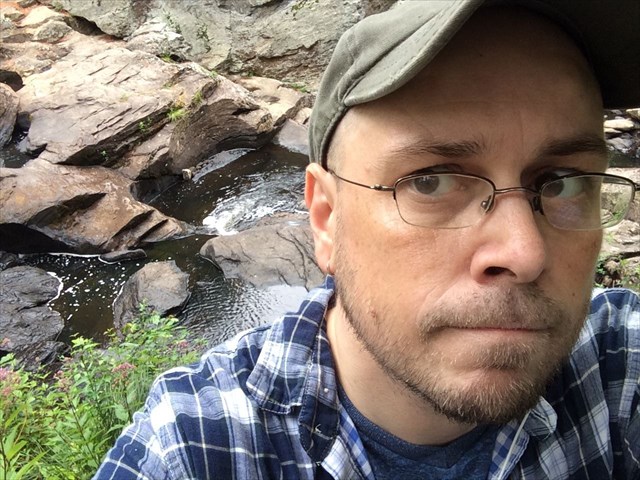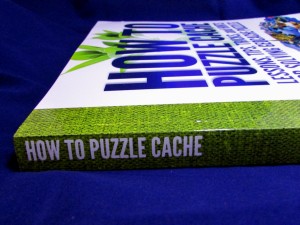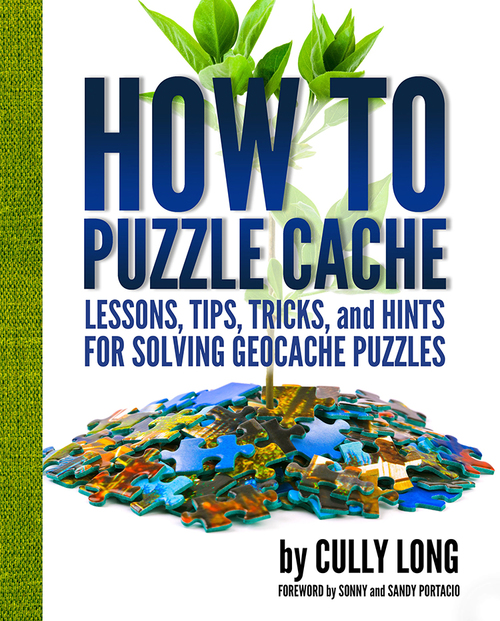Here is the original non-edited interview of Cully Long in English. I want to thank Cully for the interview!
Löydät suomenkielisen haastattelun täältä.
Background
When did you start geocaching and what is your geocaching nickname?
I have been caching since 2006, and cache under the name ChildOfAtom.

How many geocache finds do you have?
I currently have 1,081 cache finds, nearly 20% of which are puzzles. Seems like a low number until you realize I haven’t owned a car in nearly 10 years!
How many caches you own? How many of them are puzzles?
I currently own 22 caches, 19 of which are puzzles.
How did you found out about geocaching?
I honestly don’t remember. I have a vague memory of reading a magazine article about it sometime in 2004 or 2005, but I didn’t own a GPS at the time. In 2006 I was working at a theatre in a very rural area where there wasn’t much to do. I bought my first GPS from the clearance shelf at a sporting good store and went geocaching for the first time as a way to entertain myself while I was working out in the woods.
What do you do outside geocaching?
Professionally I am a scenic and costume designer for theatre. For fun I am an artist, and I love to sketch around the city, on the subway and other places.
What is your favourite thing about geocaching?
I love the “secret” side of caching. The idea that there is a secret world, hidden just under the skin of the real world, and that if you know how you can peek underneath and find all sorts of treasures that the average person is simply walking past.
What is most memorable geocaching moment you have experienced?
A few years ago I completed a series in New Jersey called “Lost Cities.” A series of 13 caches that are based on the cities associated with lost civilizations, both real and mythical. Each one is a puzzle cache, based on the language or mathematics of that city, and all of the finals are in a swamp. Collected all 13 requires a 7 mile hike, through sometimes thigh high water and mud, but it was the most adventurous day of caching that I can ever recall. It was also the first cache I’d ever done that required me to purchase special equipment. In this case a pair of waders. Completing those caches, my partner and I both muddy and tired, was an awesome accomplishment. We really felt like explorers of lost worlds that day.
What is your favourite cache? Why?
My favorite cache ever is unfortunately no longer active. It was a 12 stage night multi, and each stage was also a puzzle. It was themed after Greek mythology and included such things as crawling through a concrete pipe underneath a road for several hundred meters, climbing several trees, riding a zip-line, and crawling into a cave, all in the dark. The puzzles were also great, things like assembling the components of a ladder so that you could reach something in a tree, or sticking your hands into a box filled with creepy rubber worms in order to read a Braille message. But my favorite stage involved an electronic puzzle that resulted in an astronomical laser activating. You had a short time to follow the beam across a meadow before it went off again. It was a great cache.
What is your favourite cache type?
Puzzles, naturally! Actually, in recent years I have really fallen in love with Challenge caches, especially the more esoteric ones. I completed a challenge recently called the “Frankenstein Challenge” that required you to find a certain number of caches with body parts in the title. That was great fun.
What kind of puzzle caches you enjoy?
Any well-crafted puzzle cache, that delivers that elusive “a-ha moment” will always make me happy. I do tend to be more attracted to puzzles that require some lateral thinking and logic work rather than ciphers or math.
When you create a puzzle cache, how do you come up with an idea for the puzzle cache?
Ideas can come from everywhere. I have a whole folder in my browser full of ideas that are waiting for just the right puzzle application. As an example, my cache “It Begins at the Scholars Gate” was inspired by an art installation that I saw at library. “It Begins at the Merchants Gate” was inspired by an article in a magazine discussing a mystery that the Gerald Ford Presidential Library had recently solved. A scrap of paper that they found mixed into his papers that had a strange series of words written on it. Their research into what the words meant lead me to the resource I used to create the puzzle.
Could you name a few very good puzzle caches? What makes them especially good?
5 Star New York, is an amazing puzzle. It has a quality that I love. You gather information from several waypoints, and they slowly begin to build towards a theme. I was stumped on what to do with that theme for literally 5 years, but one day it simply occurred to me that there was a second theme underneath the first, and once I investigated that the discoveries began to stack up until I knew where the cache was. It was one of the most satisfying puzzle solves I have ever experienced.
Of my own caches I get a very good response from “It Begins at the Engineers Gate” which requires the solver to build a three dimensional object from paper and then extract the coordinates from that. I think finders really respond to the tactile nature of the puzzle, something that you don’t frequently get from geocaching puzzles because they are almost exclusively online.
How to Puzzle Cache book

What How To Puzzle Cache is about?
It is a step-by-step training manual for solving some of the most common geocache puzzle types. It begins with examining the cache page itself, and then introduces new puzzle types, codes, ciphers, substitution puzzles, indexing puzzles, etc. Plus advice on what to do after you solve the puzzles.
What the book exactly contains?
It’s 17 chapters of hints, tips, tricks and lessons. Each chapter takes one puzzle type and explores it, from the basics to the advanced with explanations, examples and sometimes history or theory. The end of each chapter features two puzzles using information discussed in the chapter, one that I give a very thorough step-by-step walk through of, detailing what I would look for and how I would go about solving it. The second puzzle is left for the reader to solve on their own.
Who is the target audience of the book?
Anyone who wants to get started solving puzzle caches, or get better at them. Even the experienced solvers that I have showed it to tell me that they have found new information that they hadn’t seen before.
What do you think is the hardest thing for new cachers when they try to solve puzzles?
Like all things geocaching puzzles have common elements that appear over and over. It’s like Scrabble, eventually the good players will memorize all the words that they can spell with a Q, but without a U, and they become better players because of it. If you show up on a cache page and you don’t know ANY Of those tricks yet… it can be intimidating. Paradoxically, the more puzzles you solve, the easier they become, but you have to solve those first few to get you started, and that can be hard.
Where did you get the idea to write a book about puzzle caches?
As a puzzle CO I often get emails from people who seem to lack some of the basic puzzle solving skills, like waypoint projection or even deciphering ROT-13 by hand. The idea of creating a manual of the most basic geocaching puzzle techniques seemed like a natural solution to that. The more I asked people about it the more people I found who were excited about the idea.
What was the hardest part in writing a puzzle solving book?
Writing the puzzles! There are 30 full scale geo-puzzles, not to mention almost a hundred more partial puzzles that I use over the course of the book as examples and lessons.
Have you written a book before?
I do have one other book on the market, but it is a book of sketches, with very little text. This is my first true “book.”
How long it took you to write the book?
I was researching and writing for a year and a half, and then 8 months of editing, proofreading, showing the text to others for help, etc. It was a long process, especially since there are hundreds of puzzles and codes in the book that had to be solved and verified several times.
Did someone help you on the way?
I had tons of help! Cachers addisonbr, teamajk, mblatch, caitlin535, ruthny… they all helped along the way, giving me feedback on chapter order, the puzzles, the explanations and more. There was also a small army of “muggles” who read the book for me to make sure that it made sense to the layperson, or the newbie cacher.
How did you come up with the title?
I wanted something simple, and as easily understood as possible. A case of “exactly what it says on the tin.”
Do you give coordinates for some real caches in the book?
No, not really caches, but each set of coordinates mentioned in the book, whether they are an answer to a puzzle, or just a random set of coordinates does point to something interesting. I spent a LOT of time looking at maps and satellite images trying to find all the locations I used in the book. I figured that since there were no real geocaches at the end of the puzzles I would at least try to make the solutions interesting. Sometimes it is a sculpture, sometimes an interesting geological feature. But they all point somewhere.
Is there an e-book available? If not, any plans to release that?
Not at this time. There are over 1000 illustrations in the book, and ebooks with illustrations take much longer to compile than traditional books. I may do one in the future, but for now I am concentrating on the paper version.
What expectations you have for the newly released book?
I’ll be happy if I help introduce some new people to the true joys of puzzles. So many people are annoyed or put off by the mere presence of puzzle caches on their maps, where I think they are missing some of the greatest caching experiences they could have. If some more cachers start solving and finding puzzles, I’ll be thrilled!
Do you have links to any other good resources to solve puzzle caches you would like to share?
Tons! I have a whole chapter about it! One of my favorite resources for new puzzle cachers is the Puzzle Caching 101 series by ePeterso2. They are a great placeto get started learning the basics of puzzles.
What are your future plans (related to the book or similar future projects)?
For the foreseeable future I’ll be concentrating on marketing the book and getting the word out, but I have already had requests for a sequel based on hiding good puzzle caches rather than finding them, so who knows. As for caching I am just a few caches away from completing my Fizzy Grid for a second time, so I’ll probably spend some time working on that. Plus I have some great cache ideas that I have had on the back burner for years while I worked on this.
Any greetings for Finnish cachers?
Terve! I’ve never been to your country, but I find myself jealous of many things about it, and hope to visit someday. Caching under the Northern Lights would be epic!
More information
You can find more information on the book from http://www.howtopuzzlecache.com/ and from the Facebook page. You can follow the book in Twitter (@h2puzzlecache) or in Google Plus.
You can order the book from Lulu.com here. The price of the book depends on the edition. The price is 16.90 GBP for the spiral bound edition and 17.45 GBP (about 22 Euros) for the regular one. Shipping to Finland was 4.75 GBP. You might want to check book’s Facebook page before ordering as the author posts discounts codes there regularly.
